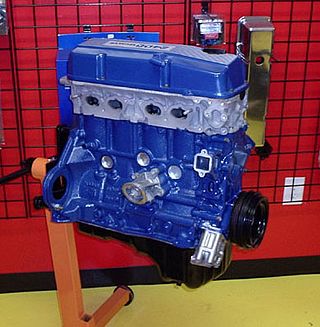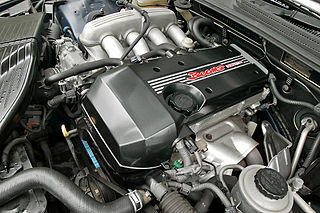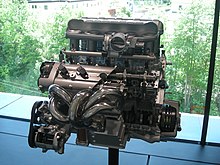
The Porsche 924 is a sports car produced by Porsche in Neckarsulm, Germany, from 1976 until 1988. A two-door, 2+2 coupé, the 924 replaced the 912E and 914 as the company's entry-level model.

The Porsche Carrera GT is a mid-engine sports car that was manufactured by German automobile manufacturer Porsche from 2004 to 2006. Sports Car International named the Carrera GT number one on its list of Top Sports Cars of the 2000s, and number eight on its Top Sports Cars of All Time list. For its advanced technology and development of its chassis, Popular Science magazine awarded it the "Best of What's New" award in 2003.

The Porsche 911, internally type 993, is the fourth generation of the 911 model of Porsche sports car, manufactured and sold between January 1994 and early 1998, replacing the 911, type 964. Its discontinuation marked the end of air-cooled 911 models.

The Porsche 964 is a model of the Porsche 911 sports car manufactured and sold between 1989 and 1994. Designed by Benjamin Dimson through January 1986, it featured significant styling revisions over previous 911 models, most prominently the more integrated bumpers. It was the first car to be offered with Porsche's Tiptronic automatic transmission and all wheel drive as options.

The Ford Modular engine is an overhead camshaft (OHC) V8 and V10 gasoline-powered small block engine family introduced by Ford Motor Company in 1990 for the 1991 model year. The term “modular” applied to the setup of tooling and casting stations in the Windsor and Romeo engine manufacturing plants, not the engine itself.
The Mazda B-series is a small-sized, iron-block, inline four-cylinder engine with belt-driven SOHC and DOHC valvetrain ranging in displacement from 1.1 to 1.8 litres. It was used in a wide variety of applications, from front-wheel drive economy vehicles to the turbocharged full-time 4WD 323 GTX and rear-wheel drive Miata.

The QR family of inline-four piston engines by Nissan were introduced in 2000 and range from 2.0 to 2.5 L in displacement. These motors are aluminum, dual overhead camshaft (DOHC), four-valve designs with variable valve timing and optional direct injection. The engine shares much of its architecture with the YD diesel engine.

The VQ is a family of V6 automobile petrol engines developed by Nissan and produced in displacements varying from 2.0 L to 4.0 L. Designed to replace the VG series, the all-aluminium 4-valve per cylinder DOHC design debuted with Nissan's EGI/ECCS sequential multi-point fuel injection (MPFI) system. Changes from the VG engine include switching to a timing chain from a timing belt, and relocating the water pump from the outside of the engine to inside the timing cover where the pump is driven by the timing chain. Later versions featured various improvements, such as variable valve timing, and NEO-Di designated VQ engines replace MPFI with direct fuel injection.

The RB engine is an oversquare 2.0–3.0 L straight-6 four-stroke gasoline engine from Nissan, originally produced from 1985 to 2004. The RB followed the 1983 VG-series V6 engines to offer a full, modern range in both straight or V layouts. It was part of a new engine family name PLASMA.

The QR family of inline-four piston engines by Nissan were introduced in 2000 and range from 2.0 to 2.5 L in displacement. These motors are aluminum, dual overhead camshaft (DOHC), four-valve designs with variable valve timing and optional direct injection. The engine shares much of its architecture with the YD diesel engine.

The KA engines were a series of four-stroke inline-four gasoline piston engines manufactured by Nissan, which were offered in 2.0 and 2.4 L. The engines blocks were made of cast-iron, while the cylinder heads were made of aluminum.

The 6G7 series or Cyclone V6 engine is a series of V6 piston engines from Mitsubishi Motors. Five displacement variants were produced from 1986 to 2021, with both SOHC and DOHC, naturally aspirated and turbo charged layouts. While MIVEC variable valve timing has also been implemented in some versions the 2.5, 3.0, and 3.5 L versions were also available with gasoline direct injection. This engine has been the flagship powerplant of the company except when they briefly built a V8 in 1999–2001. The staple of their high-end sedans, it was given twin-turbos for the Mitsubishi GTO, and became the most powerful car ever built by the company at the time.

The Suzuki G engine is a series of three- and four-cylinder internal combustion engines manufactured by Suzuki Motor Corporation for various automobiles, primarily based on the GM M platform, as well as many small trucks such as the Suzuki Samurai and Suzuki Vitara and their derivatives.

The Toyota S Series engines are a family of straight-four petrol engines with displacements between 1.8 and 2.2 litres, produced by Toyota Motor Corporation from January 1980 to August 2007. The S series has cast iron engine blocks and aluminium cylinder heads. This engine was designed around the new LASRE technology for lighter weight – such as sintered hollow camshafts.

The Porsche 911 GT3 is a high-performance homologation model of the Porsche 911 sports car. It is a line of high-performance models, which began with the 1973 911 Carrera RS. The GT3 has had a successful racing career in the one-make national and regional Porsche Carrera Cup and GT3 Cup Challenge series, as well as the international Porsche Supercup supporting the FIA F1 World Championship.

The L-series is a compact inline-four engine created by Honda, introduced in 2001 with the Honda Fit. It has 1.2 L (1,198 cc), 1.3 L (1,318 cc) and 1.5 litres (1,497 cc) displacement variants, which utilize the names L12A, L13A and L15A. Depending on the region, these engines are sold throughout the world in the 5-door Honda Brio Fit/Jazz hatchback Honda Civic and the 4-door Fit Aria/City sedan. They can also be found in the Japanese-only Airwave wagon and Mobilio MPV.

The Subaru EJ engine is a series of four-stroke automotive engines manufactured by Subaru. They were introduced in 1989, intended to succeed the previous Subaru EA engine. The EJ series was the mainstay of Subaru's engine line, with all engines of this series being 16-valve horizontal flat-fours, with configurations available for single, or double-overhead camshaft arrangements. Naturally aspirated and turbocharged versions are available, ranging from 96 to 310 hp. These engines are commonly used in light aircraft, kit cars and engine swaps into air-cooled Volkswagens, and are also popular as a swap into Volkswagen T3/Vanagons powered by the Volkswagen Wasserboxer engine. Primary engineering on the EJ series was done by Masayuki Kodama, Takemasa Yamada and Shuji Sawafuji of Fuji Heavy Industries, Subaru's parent company.

The Porsche 911 GT2 is a high-performance, track-focused sports car built by the German automobile manufacturer Porsche from 1993 to 2009, and then since 2010 as the GT2 RS. It is based on the 911 Turbo, and uses a similar twin-turbocharged engine, but features numerous upgrades, including engine enhancements, larger brakes, and stiffer suspension calibration. The GT2 is significantly lighter than the Turbo due to its use of rear-wheel-drive instead of all-wheel-drive system and the reduction or removal of interior components. As a result, the GT2 is the most expensive and fastest model among the 911 lineup.

The Porsche 3512 was a motor racing engine designed by Porsche for use in Formula One in the early 1990s.

The Porsche 991 is the seventh generation of the Porsche 911 sports car, which was unveiled at the 2011 Frankfurt Motor Show on 15 September as the replacement for the 997. The 991 was an entirely new platform, only the third since the original 911 launched in 1963. Production of the 991 generation ended on December 20, 2019, with 233,540 units produced.






















